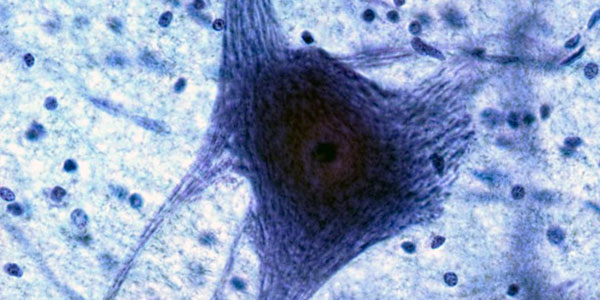Image: A micrograph of a motor neuron cell showing its extended fibers.
Researchers have long sought to develop effective biologic drugs, such as peptides, proteins and nucleic acids, for treating motor neuron diseases such as amyotrophic lateral sclerosis (ALS), also known as Lou Gerhrig’s disease. However, efforts to develop therapies for these diseases are complicated by the difficulty of bypassing the blood brain barrier. This selectively permeable structure protects the brain and central nervous system from harmful substances. However, this defense mechanism can also block helpful medications from targeting the nervous system.
Drew Sellers, research assistant professor of bioengineering, and Suzie Pun, the Robert F. Rushmer Professor of Bioengineering, have made progress towards addressing this long-term research challenge. They have demonstrated that a small peptide called TAxI, or Targeted Axonal Import, could, in mice, transport a recombinant protein into motor neurons following injection into muscle. The researchers’ study was published February 16 in the Proceedings of the National Academy of Sciences, and was also featured in UW Health Sciences’ NewsBeat.
Motor neurons lead from the spinal cord to innervate muscles and initiate movement. TAxI passes the blood brain barrier by moving from the injection site down axons, or the long projections from motor neurons that connect to muscle, to accumulate in the lumbar region of the spinal cord.
The researchers’ strategy to examine the potential of peptide delivery via motor neurons was inspired by the ability of viruses like herpes simplex virus to enter the central nervous system. Prior research has investigated the possibility of exploiting this mechanism to deliver engineered viruses and proteins that transport therapeutic agents, but such applications pose safety concerns and high production costs.
The researchers hypothesized that they could identify a peptide with a similar mechanism of action as viruses that can enter the central nervous system. Dr. Sellers, the study’s lead author, discovered the possibilities of TAxI by screening a library of over a billion possible peptide sequences from genetically modified bacteriophages, or viruses that infect bacteria.
The findings of this study reveal promising new strategies for drug delivery to the central nervous system. The work could not only lead to treatments that more effectively treat neurodegenerative diseases, but are also minimally invasive – currently, drugs are commonly delivered to the central nervous system through spinal catheters or other painful procedures.
After showing the capabilities of TAxI in early proof-of-concept experiments, the researchers next plan to further examine its mechanism of action then apply it in models of motor neuron diseases. If successful, they hope to develop it further for clinical applications.


